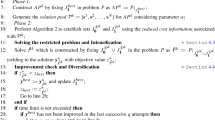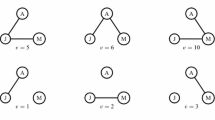Abstract
Despite a growing number of studies in stochastic dynamic network optimization, the field remains less well defined and unified than other areas of network optimization. Due to the need for approximation methods like approximate dynamic programming, one of the most significant problems yet to be solved is the lack of adequate benchmarks. The values of the perfect information policy and static policy are not sensitive to information propagation while the myopic policy does not distinguish network effects in the value of flexibility. We propose a scalable reference policy value defined from theoretically consistent real option values based on sampled sequences, and estimate it using extreme value distributions. The reference policy is evaluated on an existing network instance with known sequences (Sioux Falls network from Chow and Regan 2011a): the Weibull distribution demonstrates good fit and sampling consistency with more than 200 samples. The reference policy is further applied in computational experiments with two other types of adaptive network design: a facility location and timing problem on the Simchi-Levi and Berman (1988) network, and Hyytiä et al.’s (2012) dynamic dial-a-ride problem. The former experiment represents an application of a new problem class and use of the reference policy as an upper bound for evaluating sampled policies, which can reach 3 % gap with 350 samples. The latter experiment demonstrates that sensitivity to parameters may be greater than expected, particularly when benchmarked against the proposed reference policy.









Similar content being viewed by others
References
Balakrishnan N, Kateri M (2008) On the maximum likelihood estimation of parameters of Weibull distribution based on complete and censored data. Stat Probab Lett 78(17):2971–2975
Barry K (2013) New Helsinki bus line lets you choose your own route. Wired, http://www.wired.com/2013/10/on-demand-public-transit/, accessed June 28, 2014
Berbeglia G, Cordeau JF, Laporte G (2010) Dynamic pickup and delivery problems. Eur J Oper Res 202(1):8–15
Carriere JF (1996) Valuation of the early-exercise price for options using simulations and nonparametric regression. Insurance Math Econ 19(1):19–30
Chen A, Zhou Z, Chootinan P, Ryu S, Yang C, Wong SC (2011) Transport network design problem under uncertainty: a review and new developments. Transp Rev 31(6):743–768
Chow JYJ, Regan AC (2011a) Network-based real option models. Transp Res B 45(4):682–695
Chow JYJ, Regan AC (2011b) Real option pricing of network design investments. Transp Sci 45(1):50–63
Chow JYJ, Regan AC (2011c) Resource location and relocation models with rolling horizon forecasting for wildland fire planning. INFOR 49(1):31–43
Chow JYJ, Regan AC, Ranaiefar F, Arkhipov DI (2011) A network option portfolio management framework for adaptive transportation planning. Transp Res A 45(8):765–778
Chow JYJ (2014) Policy analysis of third party electronic coupons for public transit fares. Transp Res A 66:238–250
Chung SH, Kwon C (2015) Multi-period planning for electri-car charging station locations: a case of Korean expressways. Eur J Oper Res 242(2):677–687
Clément E, Lamberton D, Protter P (2002) An analysis of a least squares regression method for American option pricing. Finance Stochast 6(4):449–471
Cortazar G, Gravet M, Urzua J (2008) The valuation of multidimensional American real options using the LSM simulation method. Comput Oper Res 35(1):113–129
Cortés CE, Sáez D, Núñez A, Muñoz-Carpintero D (2009) Hybrid adaptive predictive control for a dynamic pickup and delivery problem. Transp Sci 43(1):27–42
Figliozzi MA, Mahmassani HS, Jaillet P (2007) Pricing in dynamic vehicle routing problems. Transp Sci 41(3):302–318
Fisher RA, Tippett LHC (1928) Limiting forms of the frequency distribution of the largest or smallest member of a sample. Proc Camb Philos Soc 24(2):180–190
Gamba A (2002) An extension of least squares Monte Carlo simulation for multi-options problems. In: Proceedings of the Sixth Annual International Real Options Conference, Paphos, Cyprus, July 2002
García D (2003) Convergence and biases of Monte Carlo estimates of American option prices using a parametric exercise rule. J Econ Dyn Control 27(10):1855–1879
Gumbel EJ (1958) Statistics of extremes. Columbia University Press, NY, republication by Dover
He F, Yin Y, Zhou J (2013) Integrated pricing of roads and electricity enabled by wireless power transfer. Transp Res C 34:1–15
Huang Y, Li S, Qian ZS (2015) Optimal deployment of alternative fueling stations on transportation networks considering deviation paths. Netw Spat Econ 15(1):183–204
Hyttiä E, Penttinen A, Sulonen R (2012) Non-myopic vehicle and route selection in dynamic DARP with travel time and workload objectives. Comput Oper Res 39(12):3021–3030
Ichoua S, Gendreau M, Potvin JY (2006) Exploiting knowledge about future demands for real-time vehicle dispatching. Transp Sci 40(2):211–225
Jung J, Chow JYJ, Jayakrishnan R, Park JY (2014) Stochastic dynamic itinerary interception refueling location problem with queue delay for electric taxi charging stations. Transp Res C 40:123–142
Karp RM (1992) On-line algorithms versus off-line algorithms: how much is it worth to know the future? Proc. IFIP 12th world computer congress on algorithms, software, architecture – information processing’92, 1:416–429
Kirschenmann T, Popova E, Damien P, Hanson T (2014) Decision dependent stochastic processes. Eur J Oper Res 234(3):731–742
Lawless JF (2003) Statistical models and methods for lifetime data. Wiley, Hoboken, NJ
Li X, Ouyang Y (2011) Reliable sensor deployment for network traffic surveillance. Transp Res B 45(1):218–231
Longstaff FA, Schwartz ES (2001) Valuing American options by simulation: a simple least-squares approach. Rev Financ Stud 14(1):113–147
Magnanti TL, Wong RT (1984) Network design and transportation planning: models and algorithms. Transp Sci 18(1):1–55
MirHassani SA, Ebrazi R (2013) A flexible reformulation of the refueling station location problem. Transp Sci 47(4):617–628
Mitrović-Minić S, Krishnamurti R, Laporte G (2004) Double-horizon based heuristics for the dynamic pickup and delivery problem with time windows. Transp Res B 38(8):669–685
Mosheiov G (1994) The travelling salesman problem with pick-up and delivery. Eur J Oper Res 79(2):299–310
Novoa C, Storer R (2009) An approximate dynamic programming approach for the vehicle routing problem with stochastic demands. Eur J Oper Res 196(2):509–515
Powell WB (2011) Approximate dynamic programming: solving the curses of dimensionality, 2nd edn. John Wiley and Sons, New York
Powell WB, Simao HP, Bouzaiene-Ayari B (2012) Approximate dynamic programming in transportation and logistics: a unified framework. EURO J Transp Logist 1(3):237–284
Sayarshad HR, Chow JYJ (2015) A scalable non-myopic dynamic dial-a-ride and pricing problem. Transp Res B. doi:10.1016/j.trb.2015.06.008
Secomandi N (2001) A rollout policy for the vehicle routing problem with stochastic demands. Oper Res 49(5):796–802
Simchi-Levi D, Berman O (1988) A heuristic algorithm for the traveling salesman location problem on 817 networks. Oper Res 36(3):478–484
Spivey MZ, Powell WB (2004) The dynamic assignment problem. Transp Sci 38(4):399–419
Stentoft L (2004) Convergence of the least squares Monte Carlo approach to American option valuation. Manag Sci 50(9):1193–1203
Szeto WY, Jiang Y, Wang DZW, Sumalee A (2013) A sustainable road network design problem with land use transportation interaction over time. Netw Spat Econ. doi:10.1007/s11067-013-9191-9
Thomas BW, White CC III (2004) Anticipatory route selection. Transp Sci 38(4):473–487
Thomas BW (2007) Waiting strategies for anticipating service requests from known customer locations. Transp Sci 41(3):319–331
Trigeorgis L (1996) Real options: managerial flexibility and strategy in resource allocation. The MIT Press, Cambridge, MA
Zhang J, Lam WHK, Chen BY (2013) A stochastic vehicle routing problem with travel time uncertainty: trade-off between cost and customer service. Netw Spat Econ 13(4):471–496
Acknowledgments
This research was undertaken, in part, thanks to funding from the Canada Research Chairs program. Constructive feedback provided by participants of the 3rd Annual INFORMS TSL Workshop held in Chicago, IL, and two anonymous referees is much appreciated. Helpful comments from Dr. Arnold Yuan from Ryerson University are gratefully acknowledged.
Author information
Authors and Affiliations
Corresponding author
Rights and permissions
About this article
Cite this article
Chow, J.Y.J., Sayarshad, H.R. Reference Policies for Non-myopic Sequential Network Design and Timing Problems. Netw Spat Econ 16, 1183–1209 (2016). https://doi.org/10.1007/s11067-015-9315-5
Published:
Issue Date:
DOI: https://doi.org/10.1007/s11067-015-9315-5




